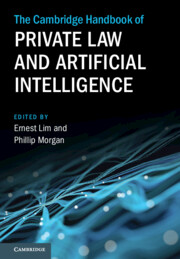Refine search
Actions for selected content:
3312 results in Artificial Intelligence and Natural Language Processing
10 - Appropriation of Personality in the Era of Deepfakes
- from Part I - Law of Obligations
-
-
- Book:
- The Cambridge Handbook of Private Law and Artificial Intelligence
- Published online:
- 21 March 2024
- Print publication:
- 28 March 2024, pp 227-249
-
- Chapter
- Export citation
3 - Contract Law and AI
- from Part I - Law of Obligations
-
-
- Book:
- The Cambridge Handbook of Private Law and Artificial Intelligence
- Published online:
- 21 March 2024
- Print publication:
- 28 March 2024, pp 71-92
-
- Chapter
- Export citation
Acknowledgements
-
- Book:
- The Cambridge Handbook of Private Law and Artificial Intelligence
- Published online:
- 21 March 2024
- Print publication:
- 28 March 2024, pp xxi-xxii
-
- Chapter
- Export citation
6 - Tort Law and AI
- from Part I - Law of Obligations
-
-
- Book:
- The Cambridge Handbook of Private Law and Artificial Intelligence
- Published online:
- 21 March 2024
- Print publication:
- 28 March 2024, pp 135-171
-
- Chapter
- Export citation
Part I - Law of Obligations
-
- Book:
- The Cambridge Handbook of Private Law and Artificial Intelligence
- Published online:
- 21 March 2024
- Print publication:
- 28 March 2024, pp 69-304
-
- Chapter
- Export citation
12 - Trust Law and AI
- from Part I - Law of Obligations
-
-
- Book:
- The Cambridge Handbook of Private Law and Artificial Intelligence
- Published online:
- 21 March 2024
- Print publication:
- 28 March 2024, pp 270-286
-
- Chapter
- Export citation
17 - Information Intermediaries and AI
- from Part II - Property
-
-
- Book:
- The Cambridge Handbook of Private Law and Artificial Intelligence
- Published online:
- 21 March 2024
- Print publication:
- 28 March 2024, pp 384-406
-
- Chapter
- Export citation
24 - Insurance Law and AI
- from Part III - Corporate and Commercial Law
-
-
- Book:
- The Cambridge Handbook of Private Law and Artificial Intelligence
- Published online:
- 21 March 2024
- Print publication:
- 28 March 2024, pp 534-556
-
- Chapter
- Export citation
Reviews
-
- Book:
- The Cambridge Handbook of Private Law and Artificial Intelligence
- Published online:
- 21 March 2024
- Print publication:
- 28 March 2024, pp ii-iv
-
- Chapter
- Export citation
1 - AI for Lawyers
-
-
- Book:
- The Cambridge Handbook of Private Law and Artificial Intelligence
- Published online:
- 21 March 2024
- Print publication:
- 28 March 2024, pp 18-35
-
- Chapter
- Export citation
Part II - Property
-
- Book:
- The Cambridge Handbook of Private Law and Artificial Intelligence
- Published online:
- 21 March 2024
- Print publication:
- 28 March 2024, pp 305-406
-
- Chapter
- Export citation
9 - Product Liability Law and AI
- from Part I - Law of Obligations
-
-
- Book:
- The Cambridge Handbook of Private Law and Artificial Intelligence
- Published online:
- 21 March 2024
- Print publication:
- 28 March 2024, pp 206-226
-
- Chapter
- Export citation
15 - Data and AI
- from Part II - Property
-
-
- Book:
- The Cambridge Handbook of Private Law and Artificial Intelligence
- Published online:
- 21 March 2024
- Print publication:
- 28 March 2024, pp 332-361
-
- Chapter
- Export citation
28 - Legal Personhood and AI
- from Part IV - Comparative Perspectives
-
-
- Book:
- The Cambridge Handbook of Private Law and Artificial Intelligence
- Published online:
- 21 March 2024
- Print publication:
- 28 March 2024, pp 618-635
-
- Chapter
- Export citation
14 - Property/Personhood and AI
- from Part II - Property
-
-
- Book:
- The Cambridge Handbook of Private Law and Artificial Intelligence
- Published online:
- 21 March 2024
- Print publication:
- 28 March 2024, pp 307-331
-
- Chapter
- Export citation
Dedication
-
- Book:
- The Cambridge Handbook of Private Law and Artificial Intelligence
- Published online:
- 21 March 2024
- Print publication:
- 28 March 2024, pp vii-viii
-
- Chapter
- Export citation

The Cambridge Handbook of Private Law and Artificial Intelligence
-
- Published online:
- 21 March 2024
- Print publication:
- 28 March 2024
9 - Implementing Text Classification Using Word Embeddings
-
- Book:
- Deep Learning for Natural Language Processing
- Published online:
- 01 February 2024
- Print publication:
- 08 February 2024, pp 132-146
-
- Chapter
- Export citation
Frontmatter
-
- Book:
- Deep Learning for Natural Language Processing
- Published online:
- 01 February 2024
- Print publication:
- 08 February 2024, pp i-iv
-
- Chapter
- Export citation
16 - Neural Architectures for Natural Language Processing Applications
-
- Book:
- Deep Learning for Natural Language Processing
- Published online:
- 01 February 2024
- Print publication:
- 08 February 2024, pp 246-271
-
- Chapter
- Export citation
